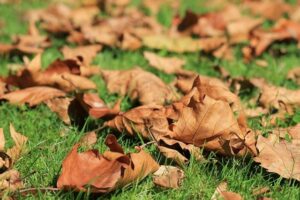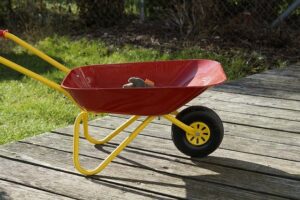Mowing in autumn – how difficult could it possibly be? You get your mower out, you start it, and you roll it over the top of your lawn, right? Sure, that’s the bare bones, but autumn is actually the most important time of year to get your mowing right. To grow and maintain the best looking lawn possible, you should keep a few things in mind when cutting your autumnal grass.
Autumn is a pivotal season in Australia because it brings so much change. From the intense heat of early March, where places like Adelaide and Perth will often top 40C, to the morning chill of late May, where the temperate climates of the south will be prone to frosts, your mowing will change with the conditions. So what do you need to keep in mind? Here are just a few things every good turf owner should be thinking about.
The Peak Growth Period
Being a country with a relatively warm climate, Australians predominantly plant warm season grasses – varieties which, as the name suggests, do far better in warm climates. Ever-popular turfs such as Couch, Kikuyu and Buffalo all fit neatly into this category, and cool season grasses are kept to the chillier climates of Tasmania and Southern Victoria.
These warm season grasses generally experience their peak growing periods from early to mid-autumn. This is thanks to the milder, less stressful conditions, the higher chance of rainfall and the warmth of the post-summer soil. This combination of factors creates the perfect conditions for the grass to explode, meaning that you’ll find yourself mowing more regularly in March and early April than at almost any other time of the year.
During this period you need to be sure to stick to the 1/3rd rule. “No more than 1/3rd of the grass blade should ever be cut off at any one time.” During the peak growing period this will inevitably lead to you mowing every weekend, although some grasses grow quicker than others. Aim for a length of 5-8cm when mowing during this time.
The Side into Winter
As the days get shorter and the weather gets colder your grass’s growth rate will begin to slow. This slowed growth will obviously affect your mowing regimen, with the weekly cut being replaced by a fortnightly one. It’s a myth that warm season grass stops growing in winter. Provided the temperature is above 5C, it simply slows down to a crawl.
Winter can be a tricky time for warm season grasses. Many of them don’t cope with frosts at all well, and varieties like Couch and Kikuyu are so reliant on sunshine that they can brown off once the daylight becomes more limited. To give these grasses the best chance at surviving such uncomfortable conditions, you want to allow the grass to somewhat grow out. This maximises the amount of sun that will hit the blade, allowing the grass to photosynthesise easier.
During late autumn, as the mornings get colder, raise your mower height from 5-8cm to 10-12cm, and continue to mow semi-regularly.
Free of Debris
One other important factor when it comes to maintaining a healthy grass in autumn is the effect that fallen leaves can have on your grass. Once again, with sun at a premium in late autumn you simply can’t afford to have your grass being denied light. For those that are a little rake-phobic, you mower (with the catcher attached) is the quickest and easiest way to pick up these leaves. You can combine your mowing and raking into one quick and easy job!
Winter is coming, but that needn’t spell trouble for your lawn. By knowing exactly how your lawn will react to the changing conditions, and altering your maintenance regime accordingly, you’ll have your warm-season lawn as healthy and happy as it can possibly be over the colder and drearier months.
If you’ve got any other questions or queries regarding autumn mowing, don’t hesitate to contact the friendly team at McKays
Does perennial ryegrass come back every year?
Perennial ryegrass is a type of grass that does indeed come back every year. This is in contrast to annual ryegrass, which only lives for one growing season before dying off. Perennial ryegrass is a popular choice for lawns and turfgrass because it is very hardy and can withstand a lot of wear and tear. It is also relatively low-maintenance, requiring only occasional mowing and watering.
How do you care for perennial ryegrass?
Perennial ryegrass is a versatile and hardy grass that is easy to care for. It tolerates a wide range of soils and climates, and is relatively drought-resistant. However, like all grasses, it does require some basic maintenance in order to stay healthy and looking its best.
Mowing is the most important aspect of care for perennial ryegrass. It should be mowed regularly, at least once a week, to keep it from getting too tall. The height of the grass should be kept at around 3 inches. This will ensure that the grass stays dense and lush, and prevents it from developing bare patches.
Perennial ryegrass also needs to be fertilized periodically. A slow-release fertilizer should be applied every 6-8 weeks during the growing season. This will help the grass to maintain its green color and keep it from getting thin and weak.
Finally, perennial ryegrass needs to be watered regularly. It should be watered deeply and evenly, about 1 inch per week. This will help it to develop a deep root system and stay healthy during periods of drought.
How long does perennial ryegrass take to establish?
Perennial ryegrass is a type of grass that is often used for lawns, pastures, and other areas where a grassy surface is desired. It is a fast-growing grass that can establish itself quickly, often in as little as two weeks. Once established, it is a hardy grass that can tolerate a wide range of conditions, from drought to heavy traffic.
What time of year do you plant perennial ryegrass?
Perennial ryegrass is a cool-season grass, which means that it thrives in cooler temperatures and goes dormant in hot weather. In general, you should plant perennial ryegrass between Autumn and Spring, when the temperatures are cool. This gives the grass the best chance to establish itself.
Test
test



